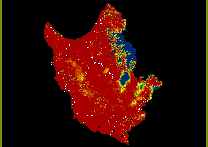Dempster-Shafer Theory of Evidence
A technique for combining multiple information sources, which is receiving increased attention in the GIS community, is Dempster-Shafer Theory (DST). This has been most often employed in decision support applications such as suitability mapping and land classification (Lein 2003, Ran et al 2008, Hubert-Moy et al 2002). More recently it has been adopted by scholars interested in the ability to predict the location of archaeological sites (Ejstrud 2003, Kvamme 2006, van Leusen 2009). Ejstrud (2003) demonstrated the superiority of its approach over various other predictive modeling approaches in terms of model performance and its conceptual benefits. DST is able to handle uncertainty and this is of particular use to the discipline of archaeology and especially so when dealing with archaeological surveys to help represent areas which have been poorly studied or where information is lacking.
"The greatest merit of DST-based predictive modeling is its capability to explicitly handle uncertainty. In predictive modeling, uncertainty often arises because there is direct evidence for the presence of a site, but only indirect evidence for the absence of one."
(van Leusen et al. 2009, p137)
Implementation of DST begins with a hierarchical structure of hypotheses known as the frame of discernment, or the decision frame (i.e., the set of alternative hypotheses or classes that can be assigned to entities). DST assumes that ignorance exists in the body of knowledge and explicitly recognizes that the knowledge base present supporting a hypothesis may be incomplete. Also it assumes that the belief for a hypothesis does not have to be the complement of belief of its negation.
Belief - The degree to which evidence provide concrete support for a hypothesis.
Plausibility - The degree to which the evidence does not refute the hypothesis.
Belief Interval - The difference between the Belief and Plausibility.
The objective of this study is to evaluate the probability that an archaeological site may be found in each pixel location in a surface representing the West of Cyprus. Given our knowledge about the existing archaeological sites in the West of Cyprus, each line of evidence gathered can be transformed into a layer representing the likelihood that a site exists. By aggregating this evidence results can be produced which allow a prediction to the presence of archaeological sites, evaluation of the impact of each line of evidence to the total body of knowledge, and an identification of areas for further research (Eastman 2009).
In an archaeological site prediction model the frame of discernment (the set of alternative hypotheses) includes two basic elements: 'site' and 'non site'. The resulting hierarchical combination of all possible hypotheses therefore includes 'site', 'non site', and 'site, non site'. Of most interest to this study are the results produced for the hypothesis 'site', but it should be noted that the existing evidence used may support any of the possible hypotheses. Ultimately the results produced for the hypothesis 'site' will be dependent on how all the evidence relates to each other in the process of agglomeration. This evidence may support other hypotheses but will still affect, indirectly, the total belief in 'site' (Eastman 2009).
"DST gives us the possibility to transfer a certain amount of the basic probability mass (called uncommitted mass) to the uncertainty hypothesis {'site', 'no site'} and thus allows us to postpone decisions about 'no site' until better information becomes available."
(van Leusen et al. 2009, p137)
This is an important aspect of DST as it easily allows for the incorporation of data into the model which is obtained at a later date. For ongoing survey projects like the Western Cyprus Survey this would be of great benefit.



